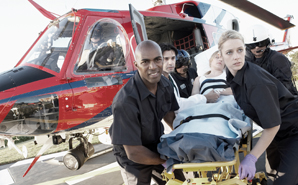In this “field edition” of worst-case scenarios, things can get complicated without the backup of hospital resources. We salute nurses who work outside four walls in military field service, flight nursing, home health and in makeshift clinics around the world.
Your worst nightmare scenarios, part 2: Field edition
1. While driving to work at the nearest hospital 20 miles away, you witness the car in front of you veer off the two-lane country road, barrel-roll down an embankment, and impact a large tree on the driver’s side door. What should you do?
Two things apply in almost all states and countries outside the US: Get more help and keep yourself safe. In the US, call 911 as soon as possible and follow the instructions of the operator. If you feel unsafe approaching the crash for any reason, stay away.
Some states and countries have “duty to rescue” laws for trained medical personnel. Familiarize yourself with these laws so you can act accordingly.
2. You finish seeing your last home health patient of the day, and wearily trudge out to your car in the dimming twilight. You are once again relieved to be leaving this questionable area of town. As you open your car door and sink into the driver’s seat, you notice the passenger side window is missing, glass litters the interior of the car, and several items are missing, including your laptop bag that was shoved under the front passenger seat. As you grab for the cellphone in your pocket, you hear gunshots a short distance away. What should you do?
Leave your car immediately and return to your patient’s home. Do not stay in the open and do not drive away from the scene. You may be driving right into the area where the gunshots were fired. As in the previous scenario, call 911 and follow the instructions of the operator. You will need to file a police report and contact your home health agency as soon as possible to notify them of the missing laptop. Taking time off and requesting a traumatic stress debriefing may be ideal…or required by your agency.
In the future, request a law enforcement escort for nurses seeing patients in potentially dangerous neighborhoods. Carrying a concealed weapon may not be an option or a good idea; check with your employer.
3. You are third-riding with the county ambulance service, en route to an apartment for complaint of difficulty breathing from a known COPD patient. As you walk up to the apartment door, you hear screaming begin. The medic opens the unlocked door, and you see smoke surrounding the face of a man wearing a nasal cannula, who is currently holding his face and screaming. No flames are visible. A lit cigarette is lying on the floor. What should you do?
Safety first: Turn off the oxygen source immediately, extinguish the cigarette, then remove the nasal cannula from the patient’s face. When ignited, nasal cannula releases vinyl chloride, a highly flammable gas that can exacerbate an oxygen-related fire. Follow burn protocols for airway management and fluid resuscitation.
If this man’s face were still on fire, notify the fire department. You should still turn off the oxygen source if doing so would not endanger yourself.
4. Your flight crew lands at the scene of a multiple-victim vehicle crash. A patient is ready to be transported immediately. While hot-loading the patient (rotors running), you hear a “slap” and the helicopter jolts slightly. You glance outside the helicopter to see a man lying on the ground covered in blood near the tail rotor. What should you do?
A rotor strike has occurred and the pilot should already be shutting down the helicopter. It will not be able to fly until inspected by a mechanic. At least one person should stay with the current patient, while other personnel assess the injured man on the ground, preferably after the rotor blades have stopped turning. If alternative rotor transport is not available, all patients will need to be transported by ground ambulance.
To prevent rotor strikes, the Air & Surface Transport Nursing Association (ASTNA) recommends that “hot” loading and unloading occur as few times as possible, with personnel who are trained and familiar with written protocols. A lookout person should be designated to monitor danger zones around the helicopter during hot loading.
Are you a field nurse? How have you dealt with situations like these in the past? Share with us in the comments!
Check out part 1 and part 3 of this series!


















